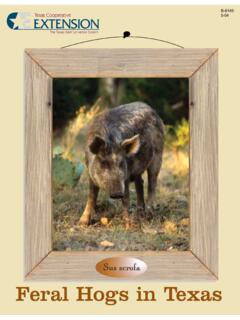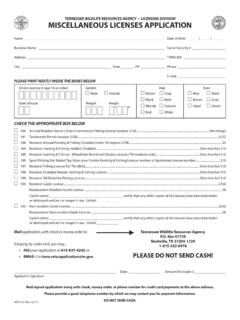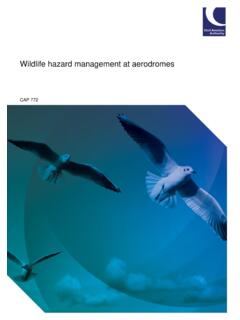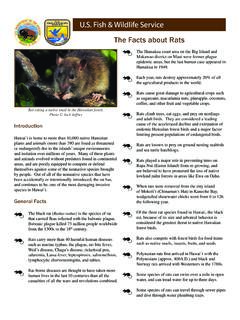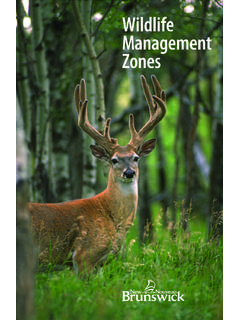Transcription of How to Build Fence with Wildlife in Mind - USDA
1 Landowner/ Wildlife Resource ProgramField services DivisionMontana Fish, Wildlife and ParksHelena, MT2008A Landowner s Guide to Wildlife Friendly Fences:How to Build Fence with Wildlife in Many land and Wildlife specialists offered their insights to this guide. Joe Weigand, Montana Fish, Wildlife and Parks Landowner/ Wildlife Resource Specialist, provided funding and guidance for the project, as well as expertise from testing various designs with landowners. Bryce Andrews conducted interviews and wrote the profiles detailing landowner and ranch manager experiences.
2 FWP biologist Jay Kolbe provided Fence specifications, photos and other invaluable contributions to the project. Ralph Burchenal, John Kountz, Marina Smith, Wayne Ternes, Juanita Vero, the Anaconda Gun Club and the Rocky Mountain Elk Foundation partnered with Montana Fish, Wildlife and Parks to test Fence designs in various livestock and Wildlife situations and provided invaluable insights and suggestions. Many biologists and resource professionals around the provided references and insights from their experience via email and listservs thank you Christine Paige, Ravenworks Ecology, Stevensville, MT.
3 Design Seiler Design & Advertising, Missoula, MT. Jenne Illustration, Missoula, MT. Paige, C. 2008. A Landowner s Guide to Wildlife Friendly Fences. Landowner/ Wildlife Resource Program, Montana Fish, Wildlife and Parks, Helena, MT. 44 pp. FWPW ildlife and Fences ..2 Problem Fences ..3 Wildlife Friendly Fences ..6 Getting Started .. 6 Fence and Crossing Placement .. 6 Friendly Designs ..8 Visibility .. 9 Sites with Low or Seasonal Livestock Use ..11 Sites with High or Continuous Livestock Use ..17 Openings, Crossings and Passes.
4 23 Remedies for Existing Fences .. 32 Fence Alternatives .. 33If You Must Exclude .. 35 Getting Help .. 40 Table of crisscross Montana landscapes like countless strands of a spider s web. Barbed-wire, woven-wire, jackleg and other fences define and divide ranches and farms, outline property boundaries, enclose pastures and rangelands, and run for miles along highway and road corridors. Yet fences can be barriers and traps for Wildlife , from big game animals to birds, causing injury and unnecessary fatalities.
5 Animal damage to fences is also costly and frustrating for share our lands with a rich and abundant array of Wildlife in Montana Wildlife that must travel across landscapes to find food, shelter and water for survival. Too often, animals and birds are injured or killed when they collide with fences or get tangled in wires. Most people would prevent these needless deaths if only they knew all fences are problem fences. By tailoring your Fence design and placement, you can prevent injury to wild animals and lessen Wildlife damage to your Fence .
6 Many of these methods are low-cost or can save you money in the long-run by reducing the need for Fence and Fences2 Christine PaigeFWP3 What kinds of Fence cause problems for Wildlife ? Fences that: are too high to jump; are too low to crawl under; have loose wires; have wires spaced too closely together; are difficult for fleeing animals or birds to see; create a complete FencesAbove: A Fence mess adjacent landowners erected two fences, creating a nightmare tangle for : A panicked deer looks for a way through a barbed-wire : Pronghorn find it almost impossible to cross woven wire fences topped with barbed PaigeDeer, elk, moose, mountain sheep, and pronghorn are all capable of jumping fences, but barbed-wire can snag animals and tangle legs, especially if wires are loose or spaced too closely together.
7 If animals can t pull free, they die a slow and desperate death. Even when animals do clear fences, or crawl through or under the strands, they often bear countless scars from wire barbs. Some fences, especially woven-wire, can be a complete barrier to fawns and calves even if adults can still jump over. Separated from their mothers, the young-sters curl up and die of starvation, stranded and unable to follow the herd. Woven wire can also block animals, such as bears and bobcats, that are unable to leap fences and are too large to slip woven wire is topped with one or more strands of barbed-wire, the Fence becomes a complete barrier, especially for fawns, calves, pronghorn and other animals that are incapable or unwilling to jump over such a Fence .
8 Animals trying to leap a woven-wire/barbed-wire Fence are even more likely to tangle a leg between the top barbed-wire and the stiff woven PaigeChristine Paige4 Above: After crossing a highway, a black bear desperately searches for a way through a woven-wire Fence , finally climbing a power pole to leap peregrine falcon died when it collided with a Fence while diving on killdeer. Many birds are vulnerable to Fence FencesChris MayneBirds, too, collide with fences, breaking wings, impaling them-selves on barbs, and tangling in wires.
9 Large, low-flying birds such as ducks, geese, cranes, swans, grouse, hawks and owls are especially vulnerable. Waterfowl fly into fences that run near or across waterways, and low-flying hawks and owls may careen into fences when swooping in on Wood1 Jackleg or buck and rail fences are sometimes considered Wildlife friendly, but they are usually built too high, too wide and with rails placed too closely together for animals to cross or crawl through. The three-dimensional jackleg design is especially hard to leap over, and if jackleg is combined with woven or barbed-wire or placed on steep terrain, it pres-ents an almost complete barrier to ungulates and other large animals.
10 Jackleg Fence also requires high maintenance the posts and rails can rot and collapse under snow loads and GockeSwans and other waterfowl can be victims of fences strung across or near : This badly tangled pronghorn was fortunately freed by the photographer, who was able to clip the PrimmHard NumbersRecently, researchers at Utah State University completed a study of Wildlife mortality along more than 600 miles of fences in the rangelands of northeastern Utah and northwestern Colorado (Harrington 2005, Harrington and Conover 2006).











